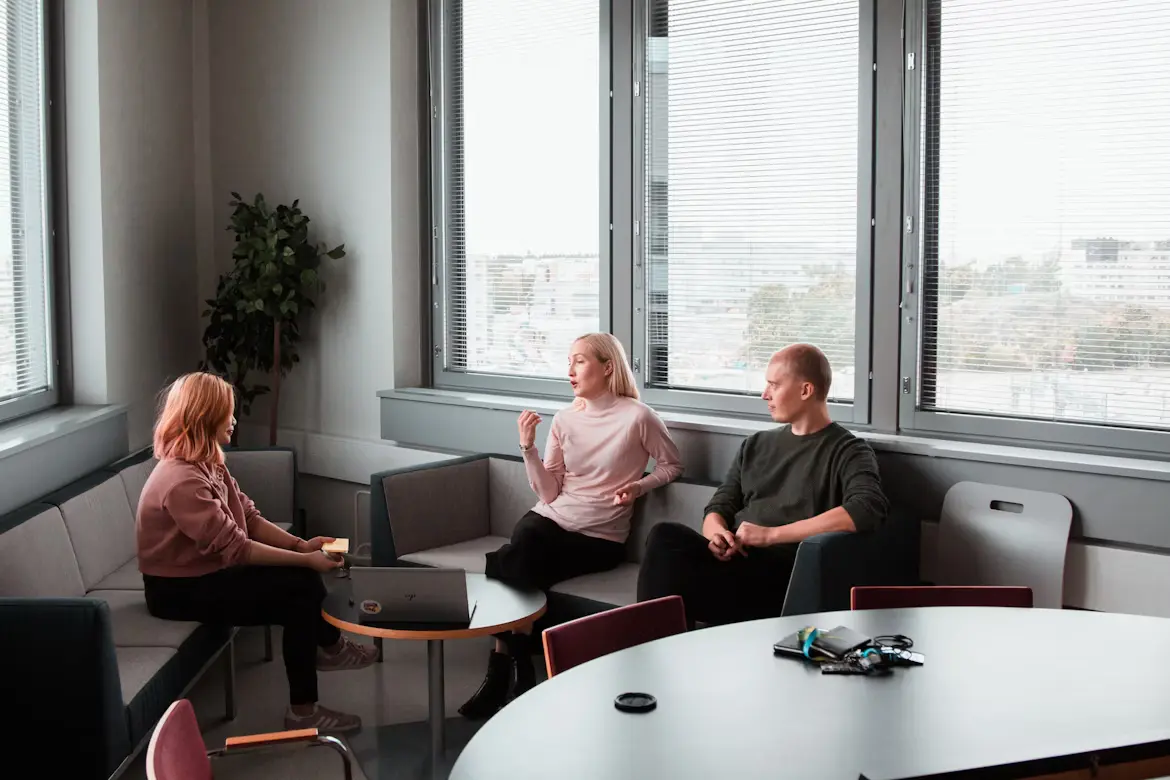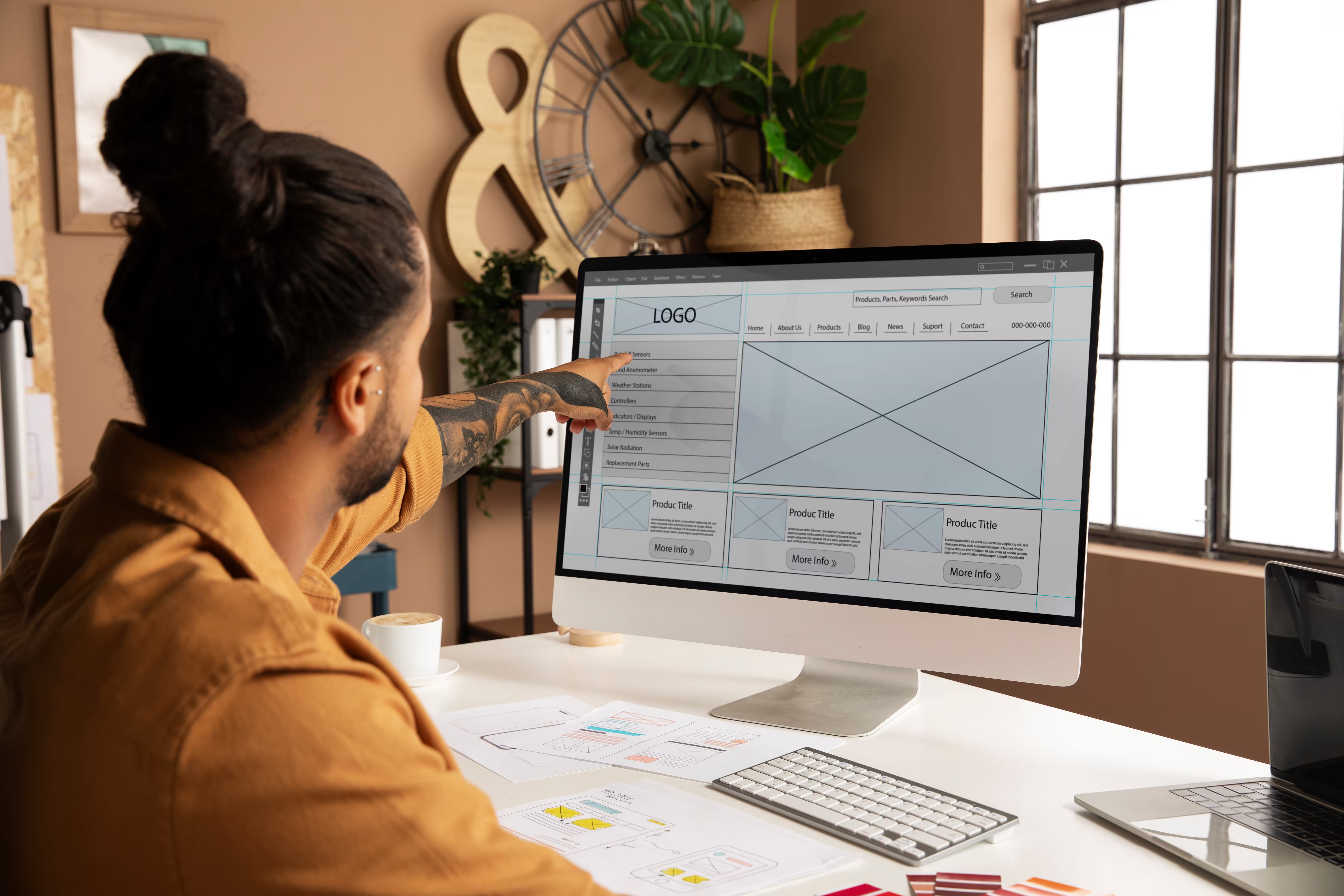But choosing the right Webflow design agency involves more than finding a team that creates visually appealing sites. Design alone is not enough. What truly sets an agency apart is its ability to build with long-term structure, performance, and scalability in mind. That means thinking beyond the canvas, developing CMS setups that are easy to manage and extend, writing clean custom code where needed, and enabling your marketing team to make updates without friction.


Why Webflow design is more than just pretty websites
Many agencies can deliver a clean layout. But design isn’t just about appearance.
In Webflow, good design is functional; it guides the user journey, communicates value instantly, and supports a seamless experience from page load to conversion.
Here’s why Webflow design goes far beyond surface visuals and what a top Webflow agency should actually deliver:
- Design is just the entry point
While visual appeal helps make a strong first impression, business value comes from structure. A well-designed site that isn’t easy to scale or update becomes a bottleneck for marketing and product teams.
- Performance drives results
Slow-loading websites frustrate users and hurt SEO rankings. Performance-optimized Webflow websites focus on fast page loads, responsive design, and clean code architecture. Great agencies implement lazy loading, defer non-critical scripts, and optimize all visual assets.
- Scalable CMS logic matters
A CMS built without logic leads to content sprawl and dependency on developers. A smart CMS enables teams to launch campaigns, update landing pages, or publish blogs without affecting the layout, which is critical for achieving enterprise velocity.
- Marketing flexibility is essential
Teams need modular components that they can reuse, edit, and launch without involving developers. Good agencies deliver reusable layouts that support real-time marketing goals without introducing inconsistencies.
- Conversion thinking is built in
High-performing agencies embed CRO and UX strategy in every build, strategic CTA placements, trust elements, and guided flows that encourage conversion. It’s not just about beauty, but business goals.
- Systemic thinking for long-term scale
The best Webflow design agencies think systemically about how performance, structure, and UX work together. This enables startups and enterprises alike to grow without reengineering the frontend every six months.
Flowout, for example, doesn’t just design pages. They architect systems that serve long-term growth. This includes using components that scale, building for reusability, and integrating performance best practices directly into the layout. That means fewer redesigns and faster go-to-market cycles.
Strategic UX and CRO principles a great agency should apply
Great design is the outcome of strategic thinking, especially around UX and CRO. The best Webflow agencies understand this and bring intentionality to every layer of the experience, from how users enter a page to how they’re guided toward a goal.
Before you decide how to choose a Webflow agency, look for signs that they think beyond surface-level visuals. Here's what strategic execution actually looks like:
- User-centered flows
Each section of a website should guide the user through a clear and logical journey. This begins by understanding their motivations and goals at every stage. For example, a well-structured SaaS landing page might start with a concise value proposition, followed by a visual explainer, then offer interactive tabs or modals using progressive disclosure to help users explore deeper layers of information at their own pace without overwhelming them.
- Clarity in the first 5 seconds
Visitors form impressions fast. A performance-optimized Webflow website needs to communicate its core offering and value clearly within the first few seconds. This includes having a sharp headline, subtext that speaks directly to the user’s problem, and a visual hierarchy that draws the eye to key actions. Clear messaging paired with a clean layout improves both engagement and bounce rates.
- Strategic CTA placement
Effective call-to-action buttons are not just well-designed, but well-placed. Webflow agencies with experience in CRO test CTA positions across different devices and content types. Some pages perform better with sticky top navigation buttons, while others convert more with mid-scroll prompts or personalized exit-intent popups that catch users just before they leave.
- Trust-building content
Conversions often depend on trust. Strategically placing elements such as customer testimonials, security badges, industry awards, or recognizable brand logos near high-stakes decisions like demo requests or pricing tables can reassure hesitant users. For example, showcasing well-known client logos at the top of the page builds credibility early in the experience.
- Built for performance
A website’s load time, mobile responsiveness, and code efficiency directly impact both user experience and SEO. The best Webflow design agency for complex builds does not treat these as afterthoughts. Instead, they optimize visuals, compress scripts, and structure pages to be lightweight and accessible from the first development sprint.
- Scalable, goal-oriented logic
Under the hood, scalable logic is what allows teams to grow fast without breaking the site. This includes using well-organized CMS collections, reusing components efficiently, and setting up clear documentation or handoffs for internal teams. A well-built Webflow site enables marketing and product teams to launch new pages or update content quickly without needing developers every time.
How the best agencies handle CMS, performance, and custom logic

When enterprise websites scale, the challenges go far beyond visuals or surface-level functionality. What truly sets leading Webflow teams apart is how they handle the deeper layers. For example, how they architect CMS logic, prioritize performance at every step, and enable custom interactions that feel seamless and scalable.
For fast-moving teams, this kind of infrastructure isn’t a nice-to-have. It’s the only way to ship faster, manage content efficiently, and retain design flexibility without breaking performance or maintainability.
Here’s how top-performing Webflow teams deliver this kind of execution behind the scenes:
Scalable CMS architecture
Modern CMS design is about more than just Collections. The best teams think in terms of relational logic, content reuse, and long-term scalability. Whether managing 50 product pages or 5,000 blog posts, the system is built with clean referencing, filtered visibility rules, and dynamic templates that let teams scale content without touching the layout. This reduces manual work and avoids rework during expansion or localization efforts.
Performance-first approach
Every image, script, and animation impacts load time. That’s why performance is embedded into the build process from the start. Agencies manually compress assets, use Webflow-native features like image lazy loading, defer non-critical scripts, and limit DOM complexity. The goal is to ensure sub-2-second loads and smooth UX across devices, even when the page includes rich media or interactive elements.
Flowout follows a rigorous approach to keep performance top-notch:
- Manually compressing images (WebP, AVIF)
- Lazy-loading videos and Lottie animations
- Deferring third-party scripts
- Custom font preloading and layout stability fixes
Case study: Flowout helped Sendlane reimagine UX and custom logic with a fullstack Webflow build
Sendlane, an email and SMS automation platform for ecommerce brands, needed a high-performance site that could match the pace of their product and marketing goals. Their legacy setup lacked modern UX polish and couldn’t support interactive features like custom blog navigation or gated content without developer bottlenecks.
Flowout stepped in as their Webflow fullstack development partner to help them scale quickly and efficiently. The project included:
- Designing and developing a JavaScript-powered custom blog sidebar that enhanced content navigation inside Webflow CMS
- Building a bespoke paywall system to gate select content for lead capture and user segmentation
- Launching a standalone microsite for their Commerce Roundtable event to streamline registrations
- Maintaining real-time iteration cycles via Slack to enable same-day feedback and execution
- Ensuring all new features were light, responsive, and performance-optimized
Result: A fast, flexible, and interactive Webflow experience that reflects Sendlane’s product sophistication, and a long-term partnership with Flowout for ongoing fullstack enhancements.
Custom logic and dynamic UI components
Some features extend beyond native Webflow capabilities, such as pricing calculators, before-and-after sliders, or interactive filtering. These are coded in with clean, modular JavaScript that enhances functionality while remaining maintainable.
Flowout’s team brings engineering-grade logic to their design builds:
- Custom calculators (as seen in Sendlane)
- Before/after sliders for medical or product showcases (Batash Medical)
- Dynamic filters for CMS-based galleries or resource hubs
- Custom nav bars, conditional popups, and interaction-driven UI states
Case study: Flowout revamped Batash Medical’s WordPress site into a conversion-driven Webflow platform
Batash Medical, a healthcare provider offering diagnostic and medical services, struggled with a slow, outdated WordPress site that hindered conversions and failed to scale new lead-generation features.
Flowout stepped in as their Webflow development partner to rebuild their digital presence with speed, interactivity, and lead-focused UX. The project included:
- Full migration from WordPress to Webflow, eliminating slow, PHP-bloated pages for a modern, agile CMS
- Shopify storefront integration, seamlessly bringing product browsing and service purchases into the flow
- Interactive before/after sliders, showcasing medical transformations and building trust
- Weight-estimate calculator, engaging users, and driving on-site interactions
- Optimized multi-step consultation form, boosting lead conversion with a user-friendly flow
- CMS-powered blog and landing pages, enabling scalable SEO growth
- Multilingual support via localization, opening up new markets, and improving accessibility
- UX design to simplify navigation, ensuring fast interactions and polished presentation
Result: A fast, smarter, conversion-ready Webflow site that elevated Batash Medical’s credibility, improved user engagement, and laid the groundwork for scalable lead generation, all powered by Flowout’s full Webflow stack expertise.
Integrations and automation workflows
No modern digital team operates in isolation. Most organizations rely on a robust software stack comprising CRMs, ticketing platforms, analytics tools, marketing automation systems, and scheduling apps to keep their workflows smooth and efficient. For the best Webflow design agency for complex builds, a website isn’t treated as a standalone asset, it’s designed as an active node within a broader operational ecosystem.
That’s why top-tier Webflow agencies focus on deep integrations, not just polished visuals. They engineer performance-optimized Webflow websites that seamlessly sync with tools like Airtable for content management, automate Slack alerts triggered by form submissions, or push qualified leads into CRMs like HubSpot and Salesforce in real time.
These agencies leverage tools such as Make and Zapier to orchestrate automation flows that reduce manual overhead. When required, they also build native API-based setups tailored to the client’s logic, tools, and business workflows. This integration-first approach ensures that marketing, sales, and ops teams get a website that not only looks good but also works hard behind the scenes.
Red flags to watch for when hiring a Webflow partner
Here are key red flags to watch out for before signing on with a partner:
- Template-heavy portfolios: If an agency showcases only cookie-cutter templates with minimal customization, they likely lack the skill to handle complex builds or create performance-optimized Webflow websites. Custom builds should be part of their demonstrated work.
- Missing case studies or real results: Lack of client success stories or before/after insights is a major concern. A top-tier Webflow design agency should confidently share tangible outcomes, like improved page speed, lead generation, or CRO metrics.
- Poor communication or unclear scope: Vague proposals, slow response times, or unclear timelines often point to disorganized project management. You need a partner who treats your business goals as their own.
- No integration or logic experience: If they can’t explain how they handle API integrations, CMS scalability, or automation tools like Zapier, they’re not ready for fullstack Webflow execution.
- Limited understanding of UX/CRO: Great design isn’t enough. Agencies must know how to design user flows, place CTAs strategically, and apply trust signals. If they skip UX strategy conversations, that's a dealbreaker.
Questions to ask a Webflow design agency before signing
Before partnering with a Webflow agency, asking the right questions helps avoid misaligned expectations and ensures you're hiring a team capable of handling your specific needs. Here are key questions to ask:
- How do you structure scalable CMS architectures for high-volume content teams?
- What’s your approach to optimizing performance (Core Web Vitals, lazy loading, script deferral)?
- Can you explain your QA and testing process across breakpoints and browsers?
- Do you offer custom logic solutions, such as calculators, filters, or dynamic animations, via JavaScript?
- How do you handle third-party integrations, such as CRM sync, analytics, and automation platforms?
- What’s your handoff process? Will our internal team receive documentation and CMS training?
- Can you walk us through a real case study similar to our use case?
- What’s your version control or backup process in Webflow projects?
- How do you handle SEO structure: semantic HTML, meta fields, schema, redirects?
- How do you plan for long-term maintainability, including component reuse, naming conventions, and modular layout systems?
Conclusion
Hiring a Webflow design agency is about choosing a long-term partner who understands scalable CMS architecture, performance-optimized Webflow websites, and your internal workflow needs. Asking the right questions upfront helps uncover not just design capabilities but also how well they handle SEO, integrations, and developer handoff.
If you're a fast-moving team looking for the best Webflow design agency for complex builds, Flowout is built for precisely that. We go beyond templates and animations; we specialize in clean CMS logic, JavaScript-rich features, and custom interactions that actually scale. Whether you’re struggling with CMS filtering, code bloat, or API sync, we don’t patch - we fix it at the foundation!
Frequently asked questions
What makes a Webflow design agency the best for complex builds?
The best Webflow design agencies for complex builds go beyond visuals. They offer fullstack capabilities like custom CMS logic, performance-optimized Webflow websites, scalable architecture, and seamless integrations. Flowout stands out by delivering dynamic, maintainable Webflow sites tailored for enterprise-grade projects.
How do Webflow agencies approach CRO and UX strategy?
Top agencies align design with business goals. They combine user research, UX best practices, and conversion rate optimisation to boost engagement. Flowout builds performance-optimized Webflow websites using strategic layouts, CTAs, and real-time trust signals that convert.
What questions should I ask before hiring a Webflow agency?
Ask about their experience with CMS structuring, Webflow performance optimization, API sync, and version control. Also, check how they handle collaboration and custom code. A partner like Flowout offers transparency, flexibility, and deep technical skills for scalable Webflow CMS setups.




















